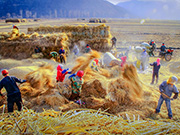

China's Tibet Autonomous Region has accomplished the historical feat of eradicating absolute poverty, said a recent press conference held by the country's State Council Information Office.
The press conference, introducing the poverty alleviation efforts of the autonomous region, also briefed the policies of the Communist Party of China (CPC) on governing Tibet for the new era.
As of the end of 2019, Tibet has removed all of its impoverished counties from the poverty list, and lifted all of the 628,000 registered impoverished residents out of poverty, reducing poverty incidence to zero. The annual net income of poverty-stricken residents increased from 1,499 yuan ($226) in 2015 to 9,328 yuan in 2019, and over 99 percent of the residents were satisfied with the autonomous region's poverty alleviation work.
Due to natural conditions and historical reasons, Tibet autonomous region was once an extremely impoverished area with the highest poverty headcount ratio, the highest cost for poverty alleviation, and the highest difficulty of poverty alleviation.
As of the end of 2015, all of the autonomous region's 74 counties were impoverished, with an impoverished population of 590,000, leading to poverty incidence of 25.32 percent.
The CPC Central Committee has always attached great importance to the work related to Tibet, and cared about the people of all ethnic groups in the autonomous region. Since China's reform and opening-up, the CPC Central Committee has convened seven central symposiums on work related to Tibet, aiming to promote the development of the region by issuing specially tailored measures and policies based on its actual conditions.
In recent years, Tibet has taken overall planning of economic and social development by eradicating poverty, and issued over 70 documents related to policies about poverty-alleviation after analyzing the reasons of poverty incidence.
China has adopted multiple measures of poverty reduction for Tibet, including developing featured industries, launching poverty alleviation relocation, promoting education and employment, implementing guaranteeing policies, and offering assistance to the autonomous region.
Since 2016, Tibet has invested a total of 39.89 billion yuan to implement 2,984 poverty alleviation projects, which lifted 238,000 people out of poverty and benefited 840,000 residents. The autonomous regions has completed building 965 poverty alleviation relocation sites, offering housing for 266,000 people. Over 90 percent of college graduates are employed, and 176,300 people from impoverished families have received training. Besides, 340,500 people in the autonomous region have secured a job other areas. All of the 110,000 impoverished residents in the region receive minimal living allowances, and 193,000 officials were sent to villages in 9 batches for poverty alleviation. In addition, 313 projects have been implemented to aid the autonomous region, with paid-in capital of 19.52 billion yuan.
 |  |

 Award-winning photos show poverty reduction achievements in NE China's Jilin province
Award-winning photos show poverty reduction achievements in NE China's Jilin province People dance to greet advent of New Year in Ameiqituo Town, Guizhou
People dance to greet advent of New Year in Ameiqituo Town, Guizhou Fire brigade in Shanghai holds group wedding
Fire brigade in Shanghai holds group wedding Tourists enjoy ice sculptures in Datan Town, north China
Tourists enjoy ice sculptures in Datan Town, north China Sunset scenery of Dayan Pagoda in Xi'an
Sunset scenery of Dayan Pagoda in Xi'an Tourists have fun at scenic spot in Nanlong Town, NW China
Tourists have fun at scenic spot in Nanlong Town, NW China Harbin attracts tourists by making best use of ice in winter
Harbin attracts tourists by making best use of ice in winter In pics: FIS Alpine Ski Women's World Cup Slalom
In pics: FIS Alpine Ski Women's World Cup Slalom Black-necked cranes rest at reservoir in Lhunzhub County, Lhasa
Black-necked cranes rest at reservoir in Lhunzhub County, Lhasa China's FAST telescope will be available to foreign scientists in April
China's FAST telescope will be available to foreign scientists in April